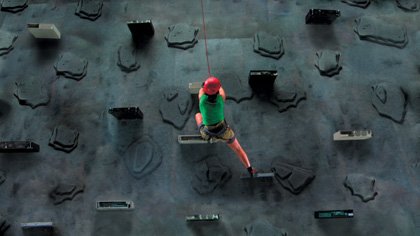Effective Motion Tracking

Even if you're on the right track, you'll get run over if you just sit there.
Will Rogers
The After Effects tracker is a semi-automated solution for two-dimensional match moving and stabilization; it helps you match the motion in source footage and apply it to target layers or remove camera motion from a shot. Set up correctly, it allows you to click a button and derive matched motion more precise than anything you could ever animate by hand.
It can save you piles of time, too, such as the several months I spent hand-matchmoving several dozen shots for Rebel Assault II using After Effects 2.0, which had no motion tracker whatsoever. The feature wasn't added until version 4.0, allowing me to learn everything I know about keyframe animating. But, having the tracker doesn't mean you get to click a button and put your feet up on the desk, George Jetson style.
First, you need to make sure you're using the tracker to best effect. Some of the most common ways to go wrong would be to
- Fail to choose good track points
- Misunderstand how the tracker does its job, and never change the default settings
- Give up on tracks that seem to have gone astray (although abandoning them may be the right idea once you understand what may have gone wrong)
- Forget about motion blur
- Fail to realize all the different ways tracking data can be applied
This chapter will help you with the above and much more.
Once you've nailed down these essential techniques, you can move on to some elegant uses of the tracker; you can
- Use the After Effects 3D camera as if it were a physical camera, matching objects you insert in the scene to the scene motion automatically
- Procedurally smooth a camera move (beyond simply stabilizing a static shot)
- Use a simple expression to continue tracking an object that becomes occluded (the track area moves offscreen or otherwise disappears)
- Bring three-dimensional depth to effects even though After Effects does not import 3D meshes
Don't forget, the tracker's uses go beyond those clearly spelled out in the Tracker Controls panel (which can always be revealed by choosing it in the Window menu, although it appears automatically upon applying a track).
Notes
The tracker is available only in After Effects Professional. If you are using After Effects Standard, skip ahead to the final section of this chapter, which focuses on importing 3D match moves from third-party software.
The Essentials |
Section I. Working Foundations
The 7.0 Workflow
- The 7.0 Workflow
- Workspaces and Panels
- Making the Most of the UI
- Settings: Project, Footage, Composition
- Previews and OpenGL
- Effects & Presets
- Output: The Render Queue
- Study a Shot like an Effects Artist
The Timeline
- The Timeline
- Organization
- Animation Methods
- Keyframes and The Graph Editor
- Uber-mastery
- Transform Offsets
- Motion Blur
- Manipulating Time Itself
- In Conclusion
Selections: The Key to Compositing
- Selections: The Key to Compositing
- The Many Ways to Create Selections
- Compositing: Science and Nature
- Alpha Channels and Premultiplication
- Masks
- Combining Multiple Masks
- Putting Masks in Motion
- Blending Modes: The Real Deal
- Track Mattes
Optimizing Your Projects
- Optimizing Your Projects
- Navigating Multiple Compositions
- Precomposing and Nesting
- Adjustment and Guide Layers
- Understanding Rendering Order
- Optimizing After Effects
- Onward to Effects
Section II. Effects Compositing Essentials
Color Correction
Color Keying
- Color Keying
- Good Habits and Best Practices
- Linear Keyers and Hi-Con Mattes
- Blue-Screen and Green-Screen Keying
- Understanding and Optimizing Keylight
- Fixing Typical Problems
- Conclusion
Rotoscoping and Paint
- Rotoscoping and Paint
- Articulated Mattes
- Working Around Limitations
- Morphing
- Paint and Cloning
- Conclusion
Effective Motion Tracking
- Effective Motion Tracking
- The Essentials
- Optimizing Tracking Using 3D
- Extending a Track with Expressions
- Tracking for Rotoscoping
- Using 3D Tracking Data
- Conclusion
Virtual Cinematography
- Virtual Cinematography
- 5D: Pick Up the Camera
- Storytelling and the Camera
- Camera Blur
- The Role of Grain
- Film and Video Looks
- Conclusion
Expressions
- Expressions
- Logic and Grammar
- Muting Keyframes
- Linking Animation Data
- Looping Animations
- Smoothing and Destabilizing
- Offsetting Layers and Time
- Conditionals and Triggers
- Tell Me More
Film, HDR, and 32 Bit Compositing
- Film, HDR, and 32 Bit Compositing
- Details
- Film 101
- Dynamic Range
- Cineon Log Space
- Video Gamma Space
- Battle of the Color Spaces
- Floating Point
- 32 Bits per Channel
- Conclusion
Section III. Creative Explorations
Working with Light
- Working with Light
- Light Source and Direction
- Creating a Look with Color
- Backlighting, Flares, Light Volume
- Shadows and Reflected Light
- HDR Lighting
- Conclusion
Climate: Air, Water, Smoke, Clouds
- Climate: Air, Water, Smoke, Clouds
- Particulate Matter
- Sky Replacement
- The Fog, Smoke, or Mist Rolls In
- Billowing Smoke
- Wind
- Water
- Conclusion
Pyrotechnics: Fire, Explosions, Energy Phenomena
- Pyrotechnics: Fire, Explosions, Energy Phenomena
- Firearms
- Sci-Fi Weaponry
- Heat Distortion
- Fire
- Explosions
- In a Blaze of Glory
Learning to See
Index
EAN: 2147483647
Pages: 157
